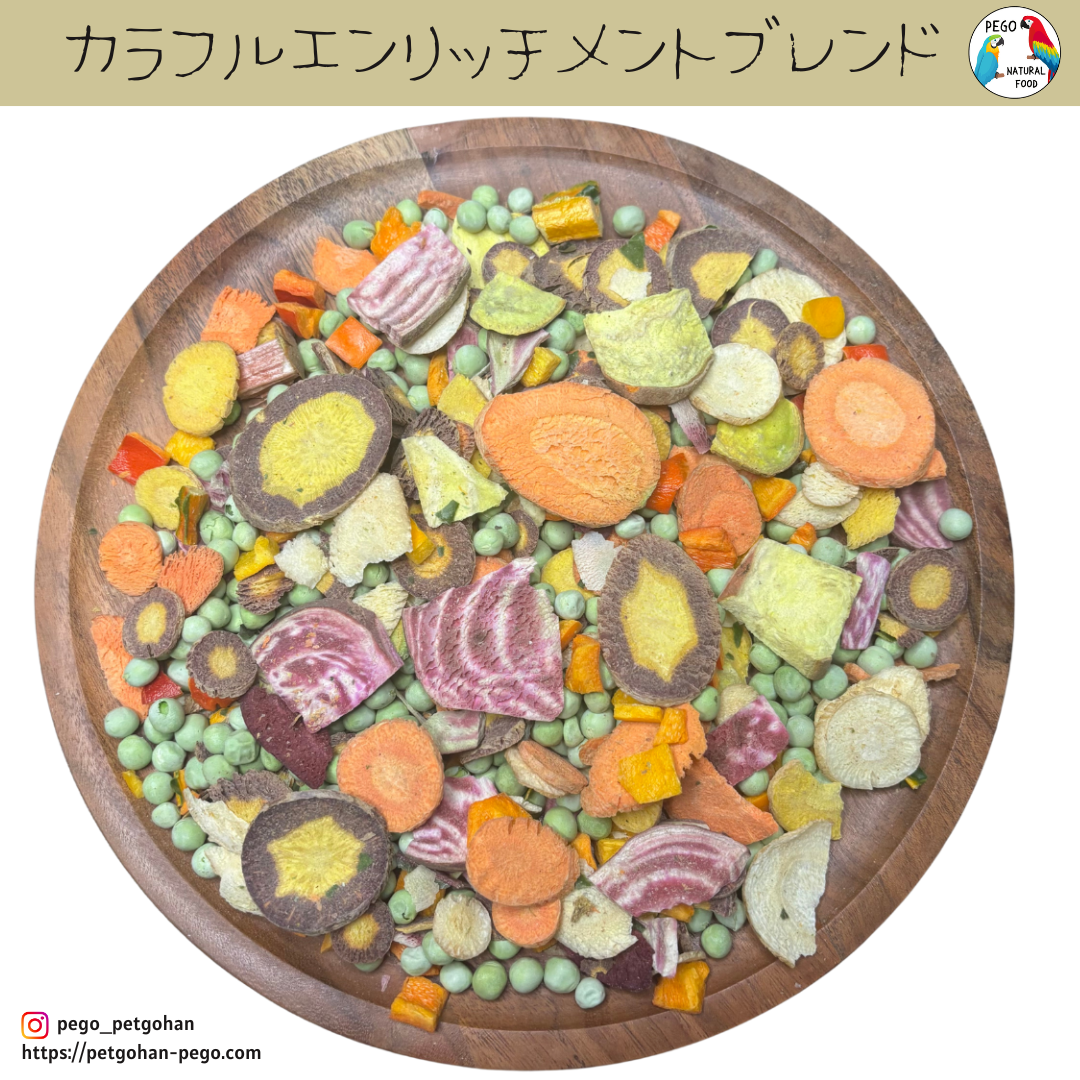
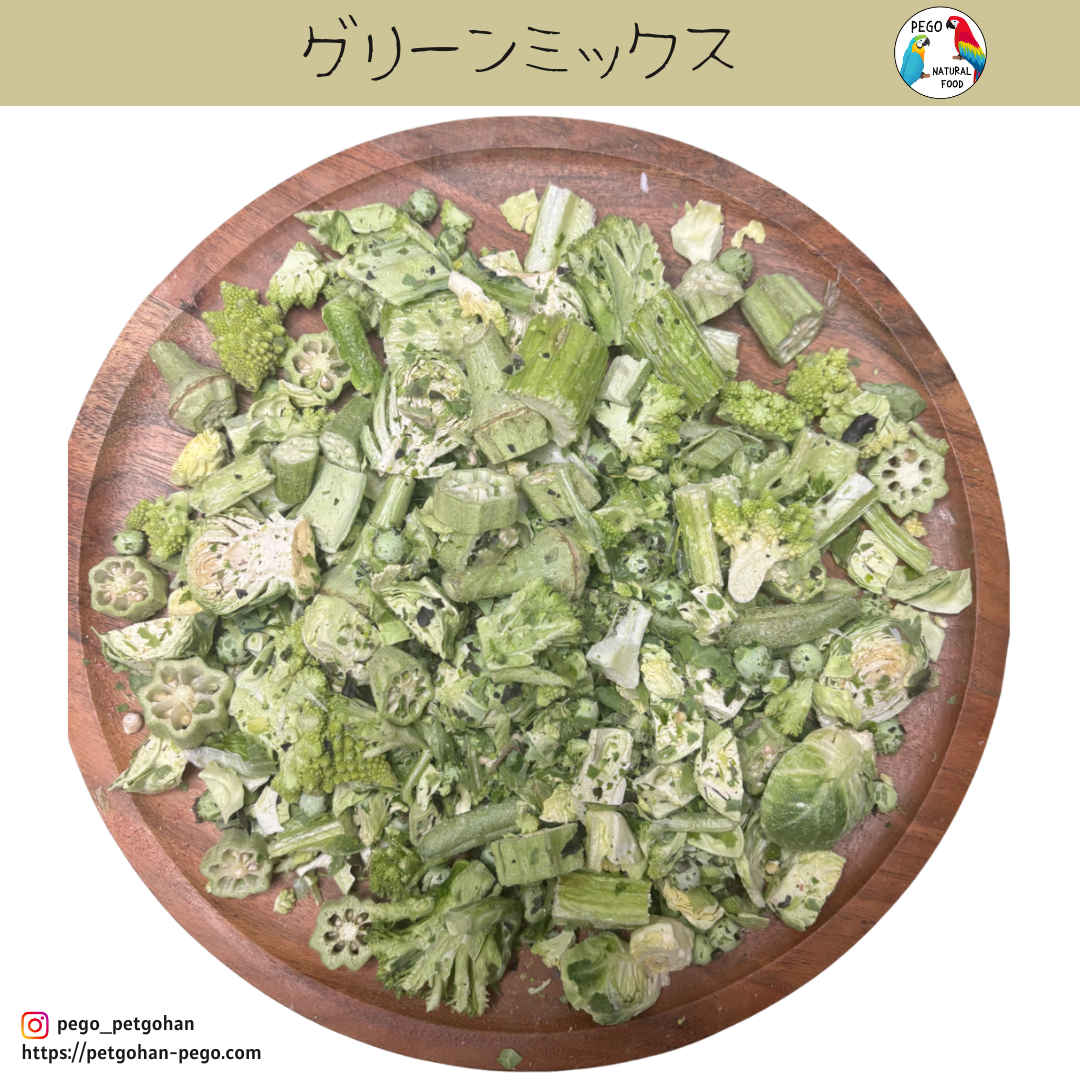

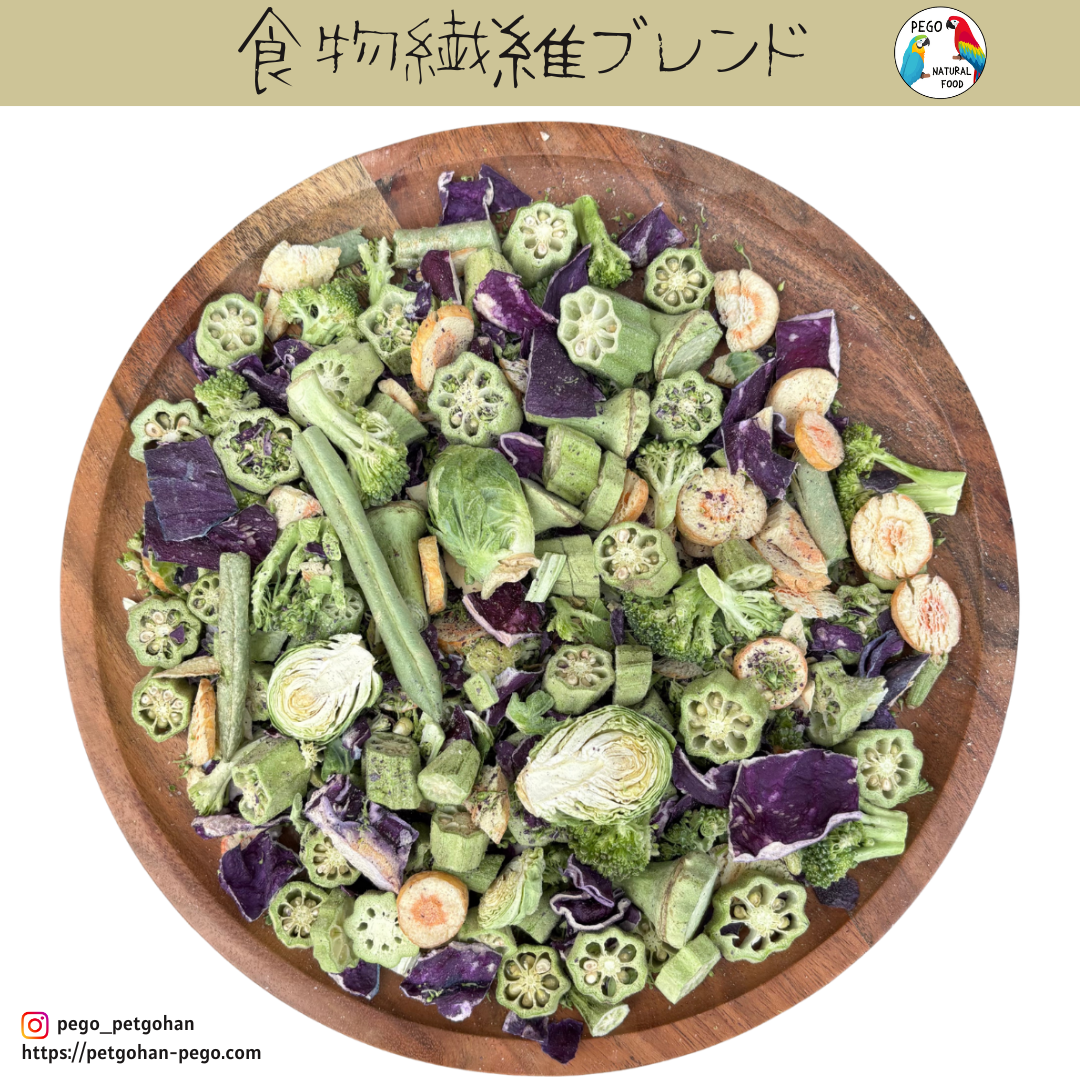

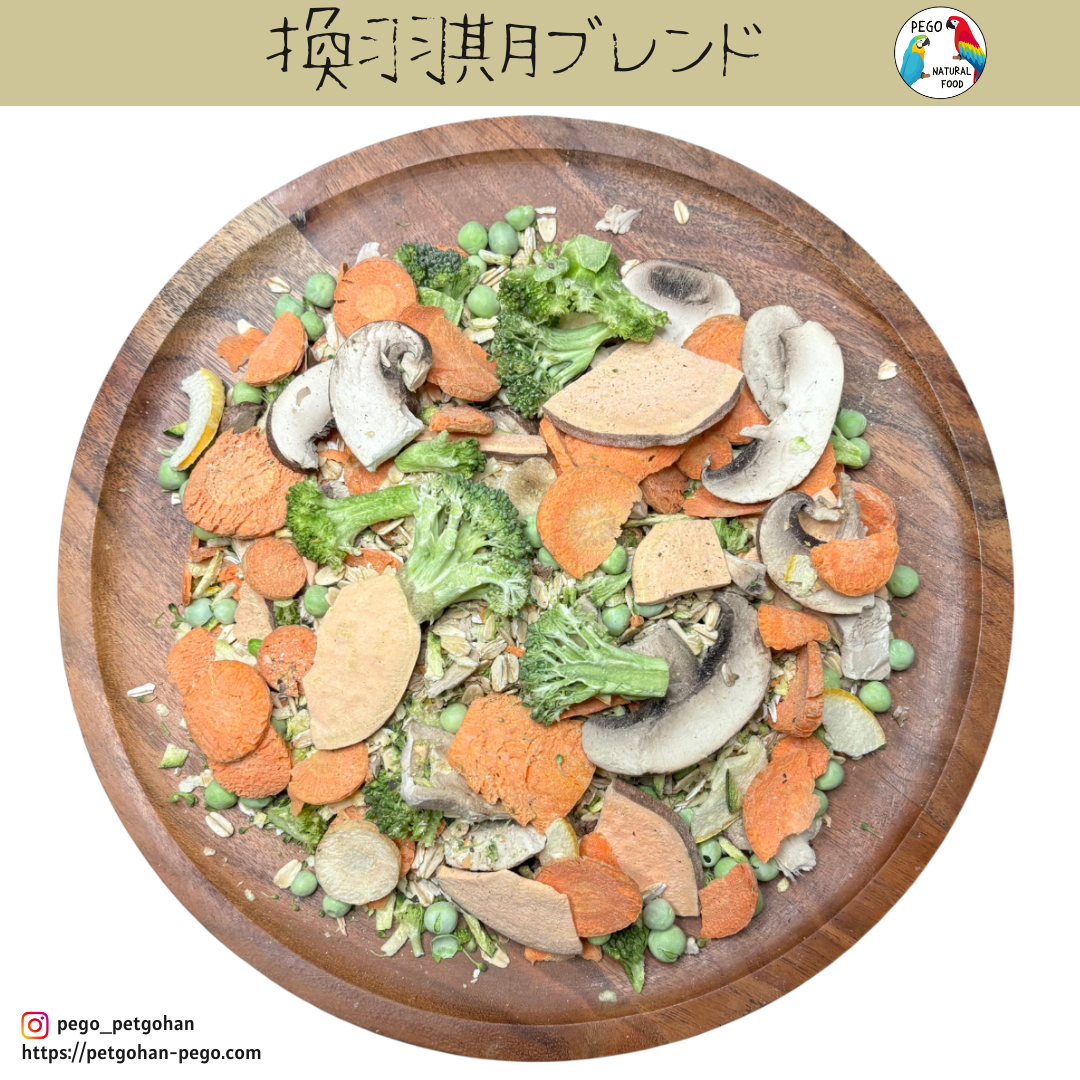
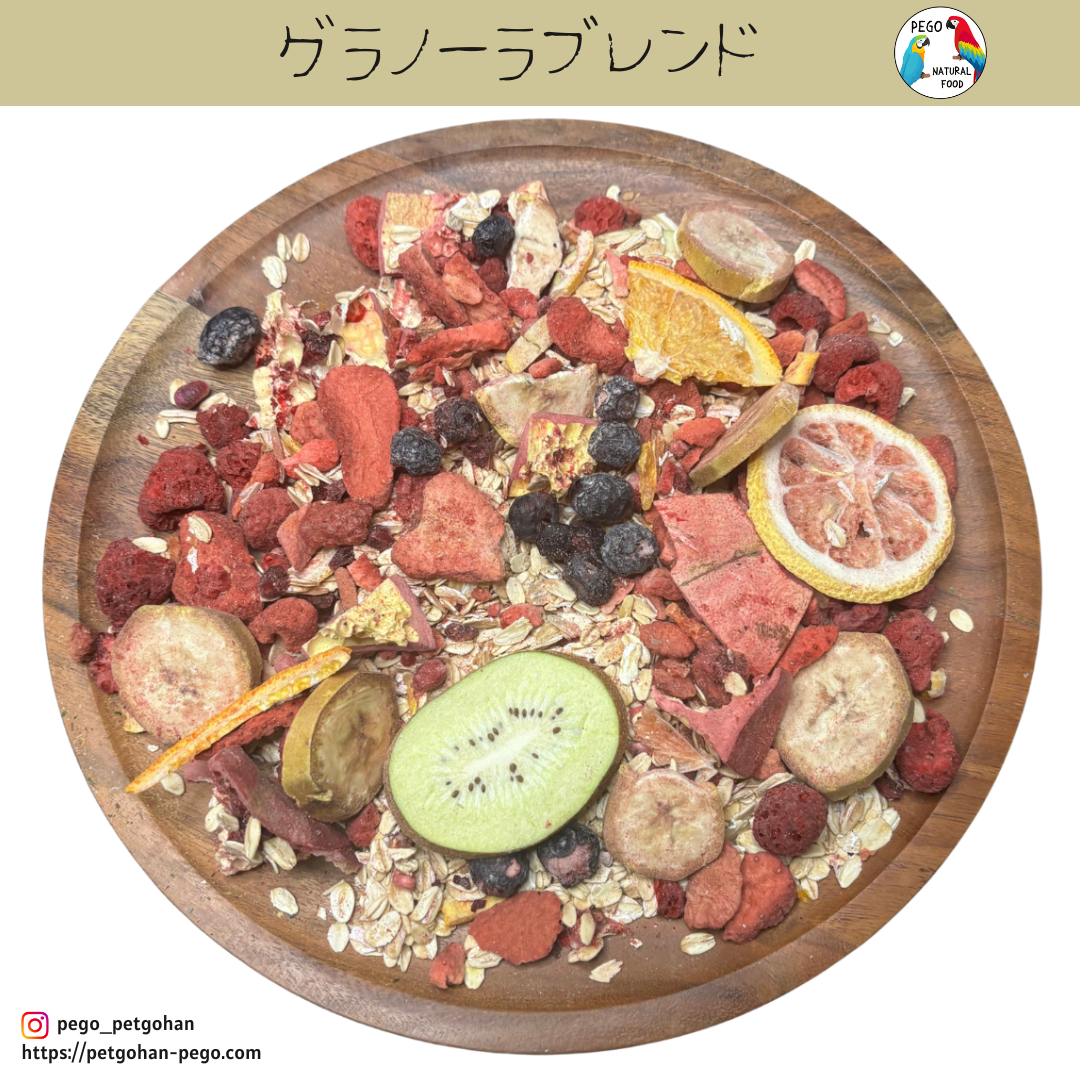
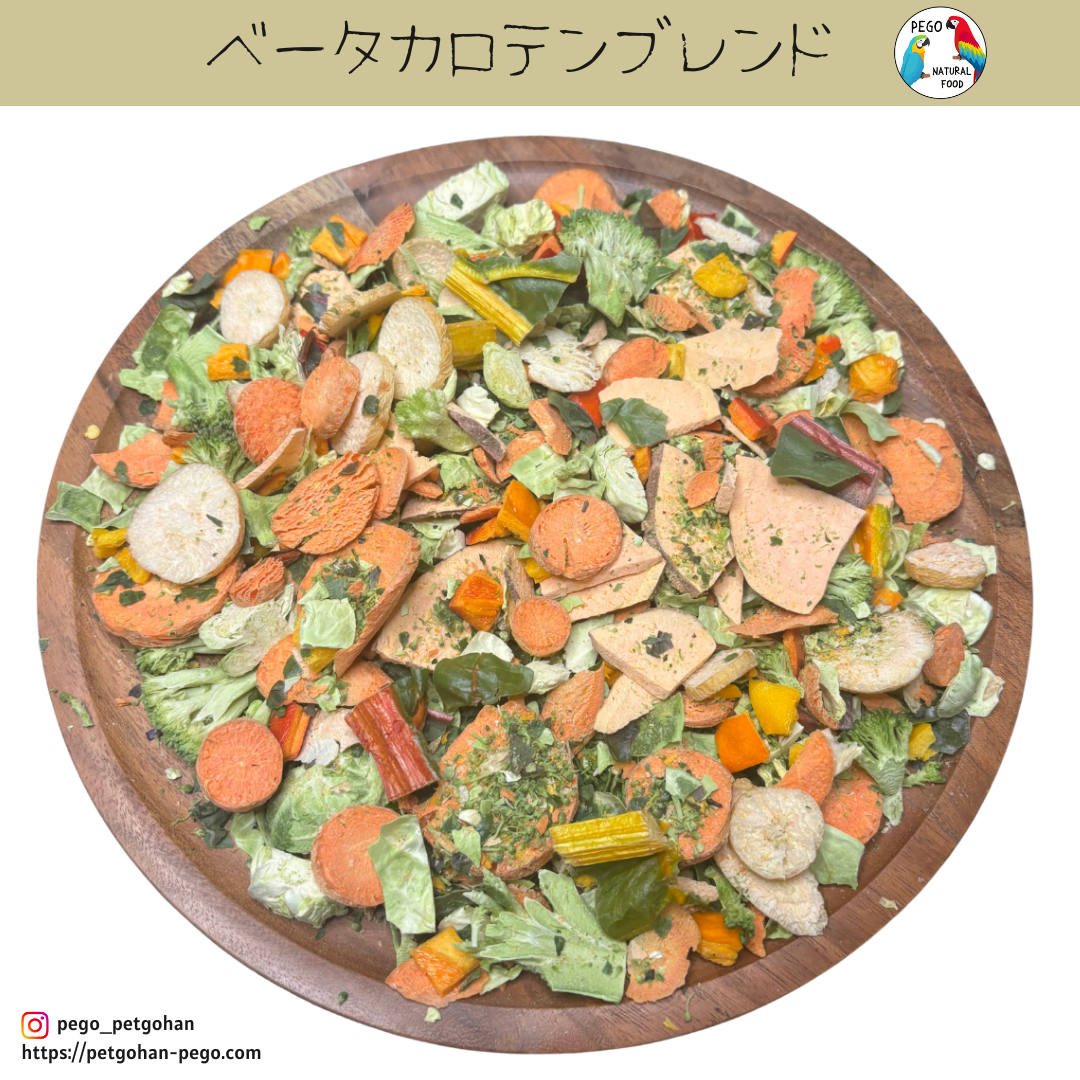

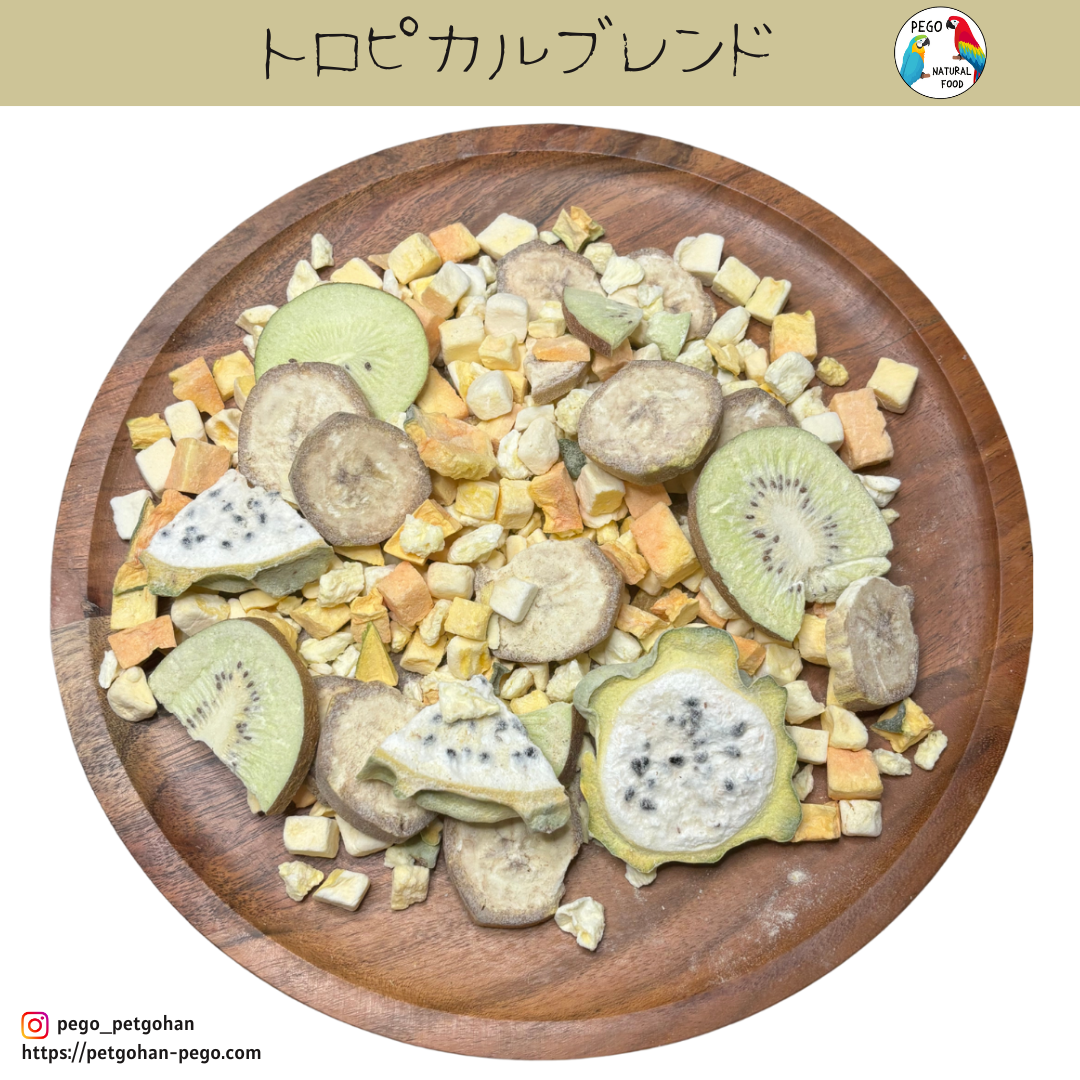
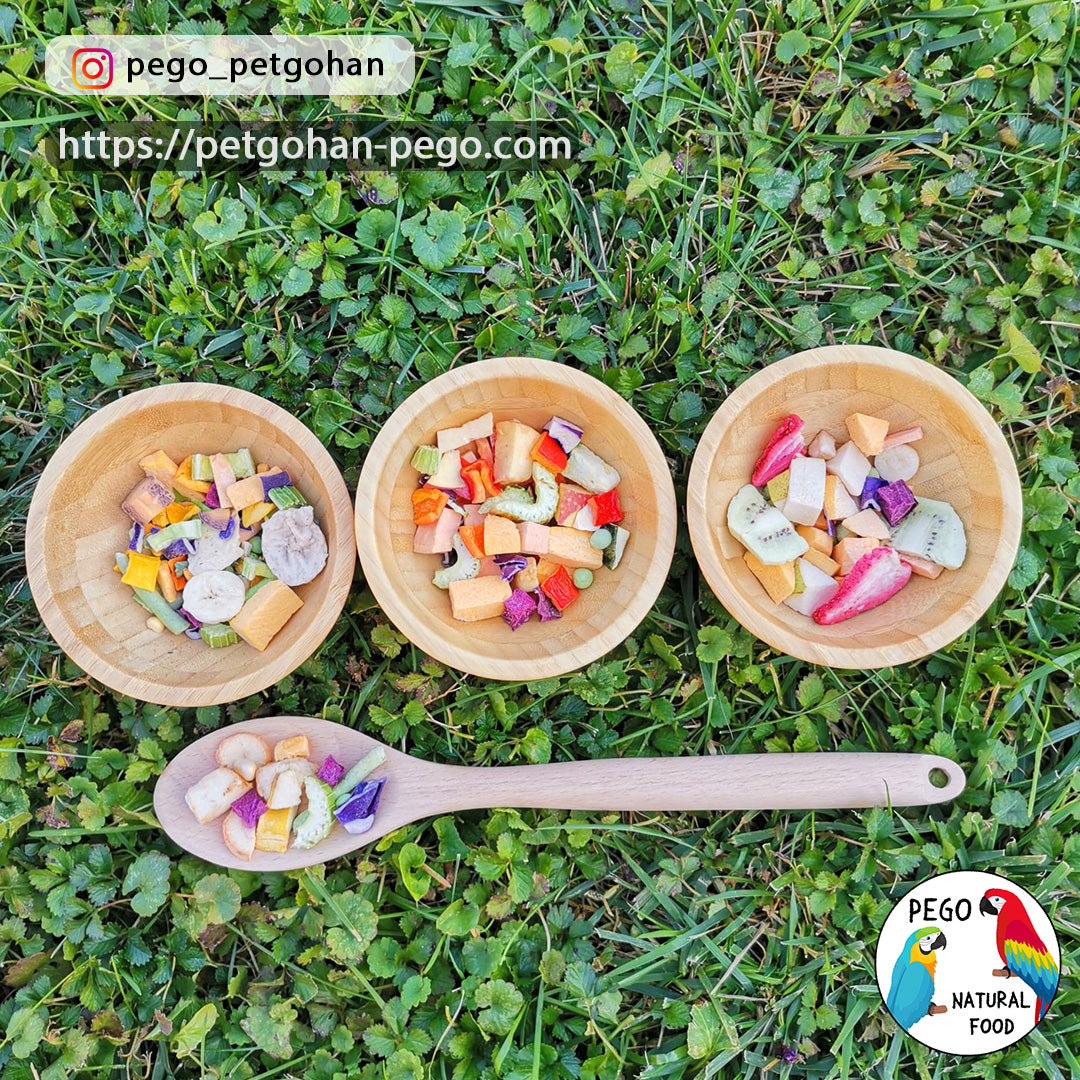
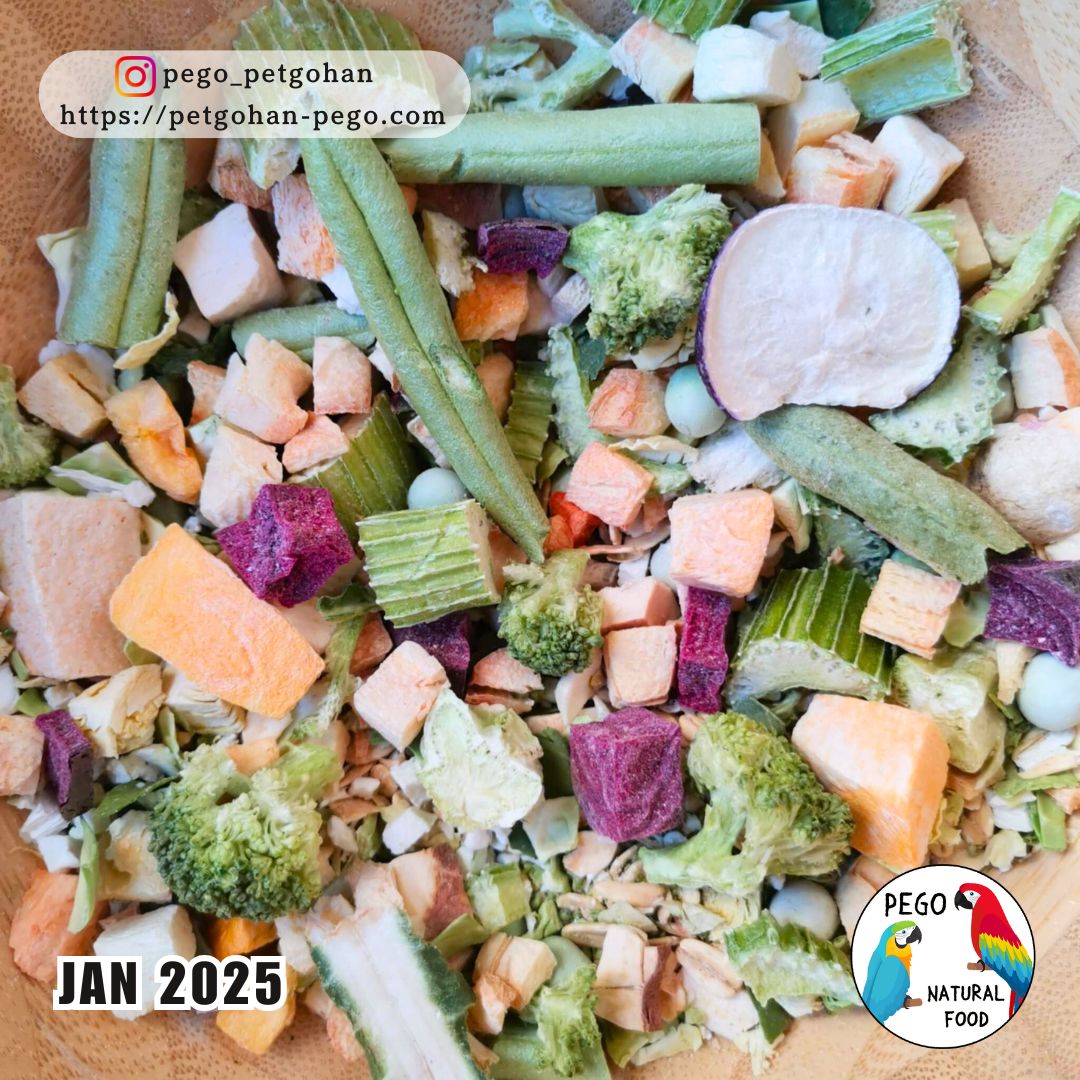

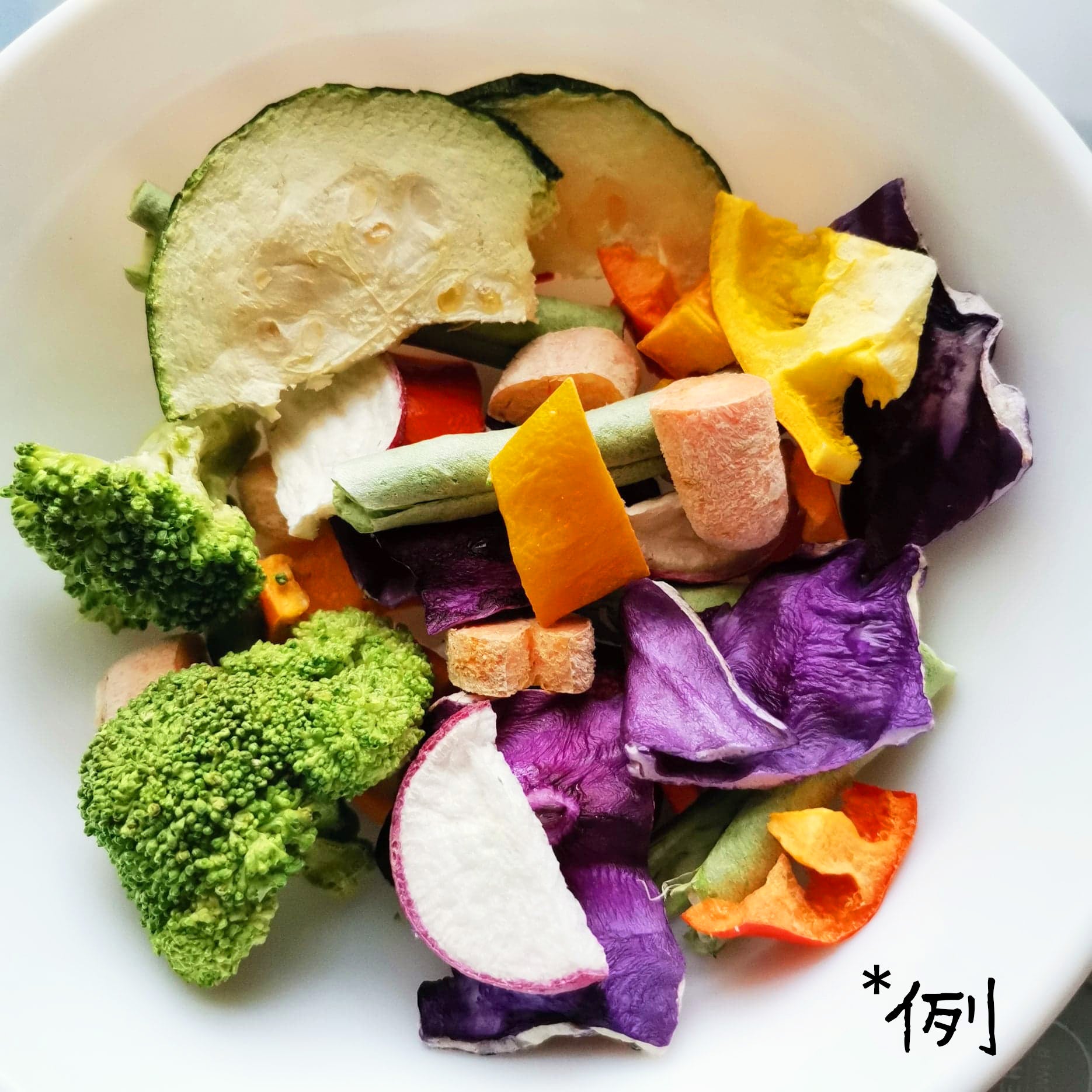

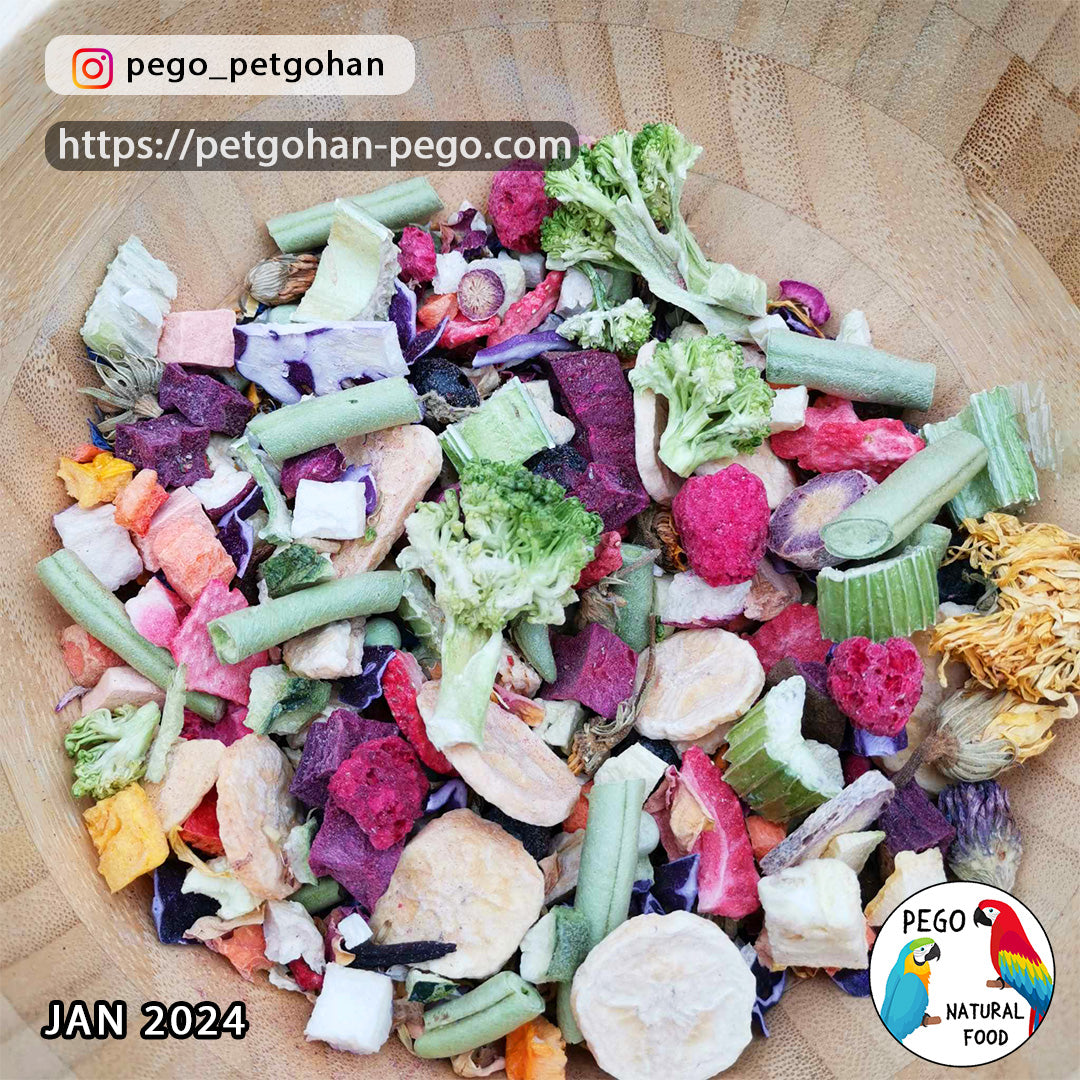
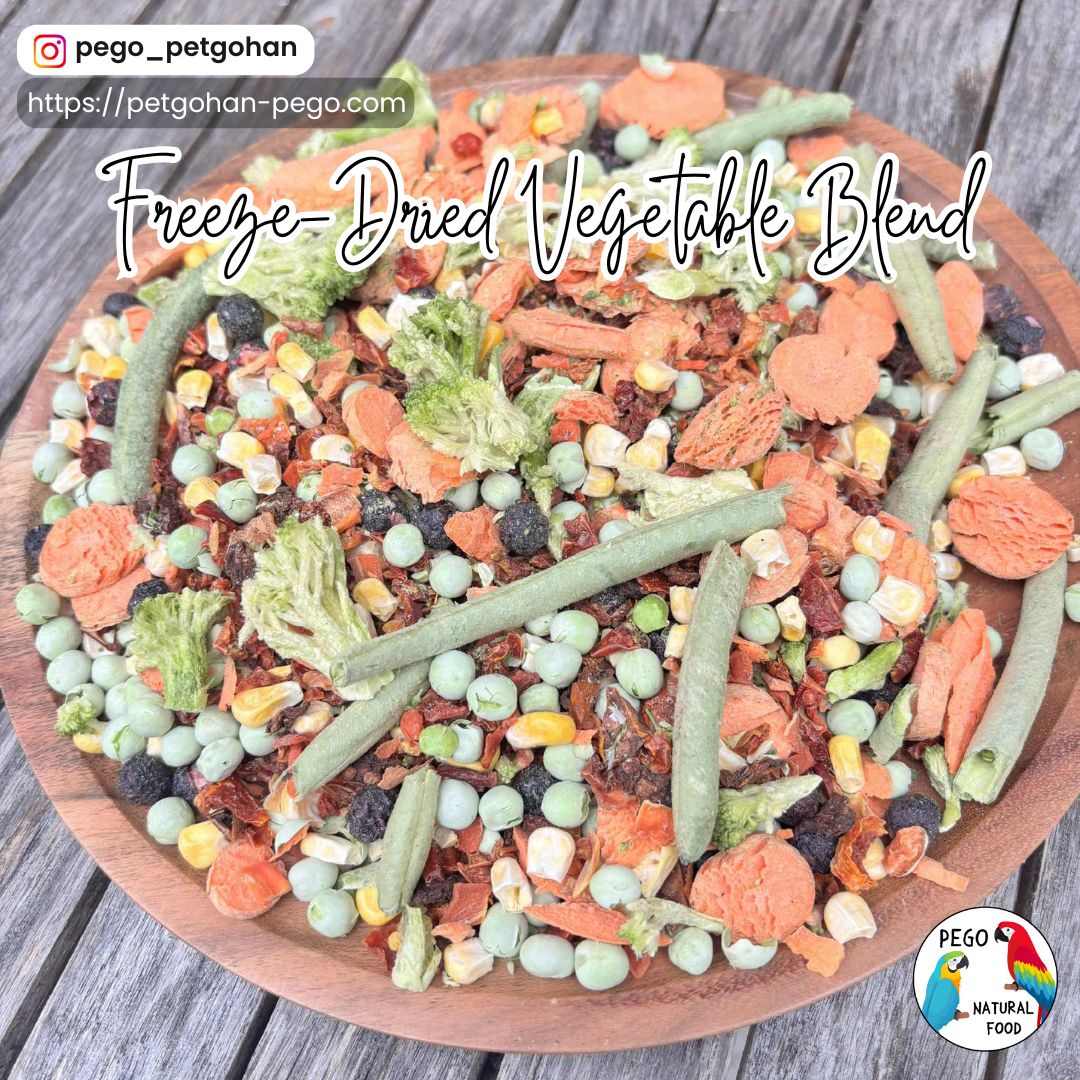
PEGO's Freeze Dried Food
Tax included.
This is our most popular product. It consistently sells out within a few days of each restock!
- Made only with USDA-certified organic vegetables, free from pesticides
- Carefully selected, safe, and healthy ingredients for birds
- Nutrients are highly preserved (up to 95%) through the freeze-drying process
- Long shelf life helps reduce food waste
- Vegetable-focused blend to encourage birds to eat more greens
- Formulated with balanced nutrition in mind—not randomly mixed
- More convenient and cost-effective than buying many organic ingredients individually
This blend is safe and appropriate for birds of all sizes.
It’s not just a treat; it’s a complete, nutritious meal.
In recent years, a growing number of bird lovers in the U.S. and Europe are reducing reliance on pellets in favor of fresh or freeze-dried vegetables and fruits.
Biologists, avian nutritionists, and veterinarians familiar with avian dietary needs also recommend freeze-dried foods.
Product Overview
What Is Freeze-Drying?
Freeze-drying is a method in which food is first frozen and then dried under vacuum by sublimating the ice (turning it directly from solid to vapor). Foods made this way are called freeze-dried.
[Why do we recommend it?]
Pellets were once commonly recommended to make up about 70% of the diet, but that view has been shifting. Today, many recommend keeping pellets around 30% and making 70% or more of the diet from whole foods—vegetables, fruits, seeds, nuts, herbs, coconut, and mealworms.
A range of expert opinions and research in Europe and North America has fueled a growing movement among some bird keepers to reduce pellet ratios and favor whole foods.
Many people find it burdensome to buy several kinds of organic whole foods every day and prepare them (washing and chopping). In those cases, freeze-dried foods are a practical alternative.
[Nutritional value of freeze-drying]
Freeze-drying can retain about 95% of a food’s original nutrients. If fresh produce is considered 100%, only about 5% is lost. Recent advances also allow these foods to be made without additives, and because little heat is used, nutrient and flavor loss is minimal. Color, aroma, and nutritional value are well preserved, so you can feed with confidence.
[Palatability]
Individual responses vary, but we’ve received many reports of birds that dislike fresh vegetables enjoying the texture of freeze-dried foods. Birds often need time to recognize a new item as “food,” so introduce it gradually. Try offering it powdered or lightly moistened to find what your bird prefers.
Parrot Species
This blend is suitable for a wide range of bird species, including finches, small to large parrots, and more.
It is also appropriate for Eclectus parrots and Galahs (Rose-breasted Cockatoos).
Please note: Suitability for lories and lorikeets has not been confirmed, so we recommend feeding at the owner's discretion.
This product may also be given to other small animals, but please check the ingredients carefully and use your best judgment when offering it.
Feeding Instructions
For best results, moisten freeze-dried food before serving. We do not recommend offering it completely dry.
Reason 1: To help prevent dehydration. Because it is very dry, it can draw water from the body and may increase water intake.
Reason 2: To support enzymes. When kept dry, the natural enzymes in whole foods are largely inactive (dormant). If you want to provide optimal nutrition, adding water may help reactivate enzymatic activity.
Feeding it dry is not “wrong,” but this guidance has been updated from a nutritional perspective. Eating comes first. If you do serve it dry, please make sure your bird stays well hydrated.
What Are Whole Foods?
In bird nutrition, “whole foods” are ingredients that wild birds could obtain in nature—fresh vegetables and fruits, seeds, nuts, herbs, coconut, edible flowers, insects, and items that are soaked or sprouted. In short, foods you can recognize at a glance.
With the exception of processed products such as pellets, supplements, and bird cookies, most of these are considered whole foods. (Seeds count as whole foods, too.)
Feeding Amount


Avian experts recommend the following amounts as a general guideline:
Small parrots: 1 tablespoon
Medium parrots: 2 tablespoons
Large parrots: 3 tablespoons
Suggested routine:
In the morning, aim to offer foods with higher moisture content.
Morning: A variety of fresh, raw whole foods
Evening: Freeze-dried food
Pellets should make up no more than 30% of the total diet, or be used simply as treats.
Introduce freeze-dried food gradually into daily meals to help your bird get used to vegetables over time.
Tips:
Small birds such as finches and budgies (budgerigars) may find the original pieces too large. If so, crush them by hand, place them in a bag and press, or grind them into smaller pieces to make them easier to eat.
Our top recommendation is to soak freeze-dried food to rehydrate it before feeding.
Storage Instructions
Store at room temperature, away from heat and humidity. Once opened, use promptly; reseal the zipper closure tightly or transfer to an airtight container. For reference, our team keeps them in airtight jars from IKEA.
Ingredients
All products are non-heat freeze-dried to preserve natural nutrients
(except for rolled oats).
All ingredients, except mealworms and crickets, are USDA-certified organic, non-GMO whole foods.
Okra and fennel are not USDA-certified, but are grown without pesticides.
All vegetables and fruits are washed with baking soda prior to processing.
All ingredients are used in their whole form (whole foods).
Ingredient names are shown as originally translated; please refer to the English names if any wording sounds unusual.
Green Blend – 50 g
Ingredients:
Baby Spinach, Baby Red Chard, Baby Green Chard, Baby Kale, Brussels Sprouts, Broccoli, Green Beans, Celery, Green Peas, Romanesco, Okra.
“Baby” refers to young leaves harvested approximately 2–4 weeks after germination.
Beta-Carotene (Vitamin A) Blend – 65–70 g
Ingredients:
Carrot, Sweet Potato, Red Bell Pepper, Orange Bell Pepper, Yellow Bell Pepper, Rainbow Chard, Broccoli, Brussels Sprouts.
Gourmet Treat Blend – 40 g
Ingredients:
Romanesco, Chioggia Beets, Golden Beets, Fennel, Mushrooms, Mealworms, Crickets.
Molting Support Blend – 100 g
Ingredients:
Green Peas, Broccoli, Rolled Oats, Mushrooms, Carrots, Sweet Potetoes, Zucchini.
Dietary Fiber Blend – 40–45 g
Ingredients:
Green Beans, Carrots, Brussels Sprouts, Broccoli, Red Cabbage, Okra.
Colorful Enrichment Blend – 50–60 g
Ingredients:
Red Bell Pepper, Yellow Bell Pepper, Orange Bell Pepper, Tri-Color Carrots, Green Peas, Beets, Rainbow Chard.
Bird Chips – 55 g
Ingredients:
Beets, Sweet Potatoes, Zucchini, Yellow Squash, Zucchine, Red Cabbage.
Value Blend – 110–120 g
Ingredients:
Dried Rolled Oats, Corn, Green Beans, Carrots, Okra.
Granola Blend – 140–150 g
Ingredients:
Dried Rolled Oats, Raspberries, Blueberries, Strawberries, Kiwifruit, Pomegranate, Banana, Orange, Lemon.
Tropical Blend – 60 g
Ingredients:
Mango, Banana, Pineapple, Dragon Fruit, Kiwifruit, Papaya.
Additional Notes
-
Seeds, stems, and peels are also included in the blends.
-
If you have concerns regarding goitrogens, oxalates, or mushrooms, please refer to our FAQ.
If you are not comfortable after reviewing the information, we recommend refraining from purchase. -
Mushrooms are sun-exposed prior to freeze-drying to encourage natural vitamin D formation.
Since this is a natural process, the exact vitamin D content cannot be quantified; however, we hope this may help birds that have limited access to sunlight, especially during winter months. -
Only bird-safe varieties of vegetables and fruits are used.
For leafy greens such as kale, we carefully select cultivars with lower progoitrin levels, based on botanical and scientific classifications.
Other leafy greens are also chosen for milder bitterness and relatively lower oxalate content.
We believe this blend reflects a very high standard of ingredient selection and quality.
Important Notice
Some ingredients (such as apples, bananas, and others) may show natural discoloration due to exposure to air during preparation.
All ingredients are freeze-dried immediately after harvest or purchase, and this discoloration does not affect quality or safety.
For this reason, returns or exchanges cannot be accepted.
Nutritional Benefit
To be updated
Best-By Date
Green Blend 12/2026
Beta-Carotene Vitamin A Blend 12/2026
Gourmet Treat Blend 12/2026
Molting Support Blend 12/2026
Dietary Fiber Blend 12/2026
Colorful Enrichment Blend 12/2026
Bird Chips 12/2026
Value Blend 12/2026
Granola Blend 6/2026
Tropical Blend 12/2026
FAQ
Q: Does this sell out quickly? When is the next restock?
A: Yes—each batch usually sells out within a few days. We’ll post restock updates on this page and on Instagram.
Q: Will the exact same blend be restocked?
A: No. We don’t repeat identical formulas. Because we prioritize dietary diversity, the ingredients change from batch to batch. If you find a blend you love, consider purchasing extra.
Q: My bird’s droppings look watery / have a different color.
A: This often means your bird is well hydrated, and certain foods—especially beets—can turn droppings red. The color usually reflects the foods eaten, so it’s not a problem. If the color changes from day to day, that’s a good sign your bird is eating a variety of foods and getting diverse nutrients.
Q: Is this recommended for my [parrot species]?
A: Ingredients vary each time, but we list any species for which we don’t recommend it under the “Parrot Species” section—please check there. In general, our blends are suitable for most species.
Q: I’ve heard that [ingredient] isn’t safe for parrots. Is this okay?
A: Yes. We use only ingredients considered safe for parrots, based on peer-reviewed data, studies, and guidance from biologists, animal scientists, certified bird trainers, and nutrition professionals in the U.S. and Europe. If guidance in your country differs and you’re concerned, please refrain from purchasing.
Q: Can I use this alongside supplements or medications?
A: As a whole-food product, it’s generally fine. Be mindful of citrus and potential interactions. When in doubt, contact the supplement or medication manufacturer and share their guidance with your veterinarian.
Q: I was told to keep whole foods under 30% of the diet.
A: It depends on why. Years ago, many recommended pellets at about 70% of the diet. That view has been shifting; today, many aim for roughly 30% pellets and 70% or more whole foods (vegetables, fruits, seeds, nuts, herbs, coconut, mealworms). In the U.S. and Europe, some keepers and experts are moving in this direction. If your bird has a specific health issue, please follow your specialist’s advice.
Q: I found seeds in the fruit / a stem on the vegetable. Is that a problem?
A: It’s not a problem. We’ve had questions about apple seeds before—we don’t suggest offering them on purpose, but a few eaten incidentally aren’t a concern. In general, fruit “seeds” are typically fine for birds, while hard “pits” (stones) should not be fed. If you’re unsure, simply remove them. Zucchini or carrot tops are also fine; remove them if you prefer.
Caution
In the United States, the Food and Drug Administration (FDA) sets maximum “defect action levels” for incidental insect matter, and those limits vary by food type and manufacturing process. Because this product uses pesticide-free ingredients and contains no additives, incidental insects may occasionally be present. Insects associated with produce or herbs (i.e., whole foods) are a natural source of animal protein and are generally not harmful to birds; however, please remove them if you prefer. Returns or exchanges cannot be accepted for issues related to incidental insects

Teks di situs ini dibuat otomatis oleh alat terjemahan dan mungkin mengandung diksi yang kurang natural. Terima kasih atas pengertiannya.
